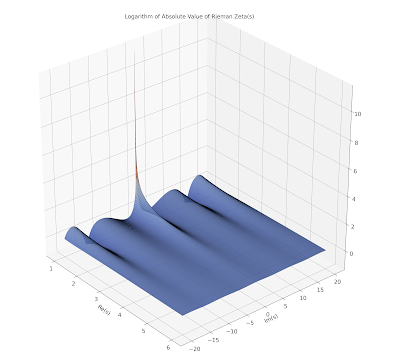The Riemann Zeta function encodes information about the primes. We've already seen how we can use it to easily prove there are infinite primes, and that the prime harmonic series diverges, telling us the primes aren't so sparse.
$$\zeta(s)=\sum_{n}\frac{1}{n^{s}}=\prod_{p}(1-\frac{1}{p^{s}})^{-1}$$
We've thought about the zeta function with s as an integer, for example the harmonic series with $s=1$, and the Basel problem with $s=2$. We've also considered $s$ as a real number, and asked whether the zeta function converges for values of $s$ between 1 and 2. We proved the zeta function converges for $s>1$.
Riemann was the first to consider s as a complex number. If we think the zeta function over the complex domain might reveal new insights into the primes, we need to understand how it behaves. Exploring where it converges is a good start.
The video for this blog is at [youtube]. Slides are online [pdf].
Convergence For $\sigma>1$
It has become tradition to write complex $s$ as $s=\sigma+it$, where $\sigma$ is the real part of $s$.
$$\sum\frac{1}{n^{s}}=\sum\frac{1}{n^{\sigma+it}}=\sum\frac{1}{n^{\sigma}}\frac{1}{n^{it}}$$
Let's look at the series with each term replaced by its magnitude.
$$\sum\left|\frac{1}{n^{s}}\right|=\sum\left|\frac{1}{n^{\sigma}}\frac{1}{n^{it}}\right|$$
Rewriting $n^{it}$ as $e^{it\ln(n)}$ makes clear it has a magnitude of 1.
$$\sum\left|\frac{1}{n^{s}}\right|=\sum\frac{1}{n^{\sigma}}$$
We've already shown $\sum1/n^{\sigma}$ converges for $\sigma>1$ where $\sigma$ is real. This tells us $\sum1/n^{s}$ converges absolutely for for $\sigma>1$. Since absolute convergence implies convergence, we can say $\sum1/n^{s}$ converges whenever the real part of $s$ is more than 1, that is $\sigma>1$.
Divergence For $\sigma\leq0$
Let's look again at the terms in the sum.
$$\left|\frac{1}{n^{s}}\right|=\left|\frac{1}{n^{\sigma}}\frac{1}{n^{it}}\right|=\frac{1}{n^{\sigma}}$$
If $\sigma<0$, the magnitude of the terms grows larger than 1. If $\sigma=0$, the magnitude of each term is exactly 1. For any series to converge, a necessary requirement is that the terms get smaller towards zero. This means $\sum1/n^{s}$ diverges for $\sigma\leq0$.
Divergence For $\sigma<1$
Having found the Riemann Zeta function converges for $\sigma>1$, and diverges for $\sigma\leq0$, we are left with a gap $0<\sigma\leq 1$. To fill this gap we need to understand more generally when series of the form $\sum a_{n}/n^{s}$, called Dirichlet series, converge or diverge.
A later blog post will explain how Dirichlet series converge in half-planes to the right of an abscissa of convergence $\sigma_{c}$. That is, they converge at an $s=\sigma+it$ where $\sigma>\sigma_{c}$.
Because $\zeta(s)$ converges for $\sigma>1$, and we know it diverges at $s=1+0i$, the abscissa of absolute convergence is at $\sigma_{c}=1$. We can now say $\zeta(s)$ diverges for $\sigma<1$.
Visualising The Zeta Function For $s>1$
Visualising a function helps us understand it. The plot below shows a surface plot of $\ln\left|\zeta(s)\right|$ for $\sigma>1$. Because the values of $\zeta(s)$ are complex, it is easier to plot the magnitude of $\zeta(s)$. Taking the logarithm scales down very large values to better show the function's features.
The spike around $s=1+0i$ corresponds to the divergent harmonic series $\zeta(1)$.
The surface seems to smooth out to the right as $\sigma$ grows larger. Again, it is natural to ask what value it approaches. Let's look again at the terms of the sum $\zeta(s)$.
$$\zeta(s)=\frac{1}{1^{s}}+\frac{1}{2^{s}}+\frac{1}{3^{s}}+\frac{1}{4^{s}}+\ldots$$
As $s\rightarrow\infty$ all the terms $1/n^{s}\rightarrow0$, except the first term which remains 1. To be more precise, the magnitude of each term $|n^{-s}|=n^{-\sigma}$ tends to zero as $\sigma\rightarrow\infty$ for all $n>1$. That means the magnitude of the function $\zeta(s)\rightarrow1$ as $\sigma\rightarrow\infty$.
Hints The Function Extends Into $\sigma\leq1$
Looking again at the plot above, we can see that aside from $s=1+0i$, the function doesn't seem to diverge along the line $s=1+it$. It looks like the surface has been prematurely cut off, and would continue smoothly into $\sigma\leq1$ if allowed.
The plot below shows a contour plot of $\ln\left|\zeta(s)\right|$. The contours do indeed appear artificially cut off, as if they should continue smoothly to the left of $\sigma=1$.
The intuition that a function should continue smoothly without abrupt changes corresponds to a powerful property of many functions we come across. If we can show $\zeta(s)$ is one of these well-behaved functions, we are then justified in trying to extend it to the left of $\sigma=1$.



No comments:
Post a Comment